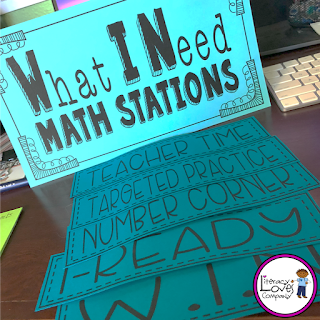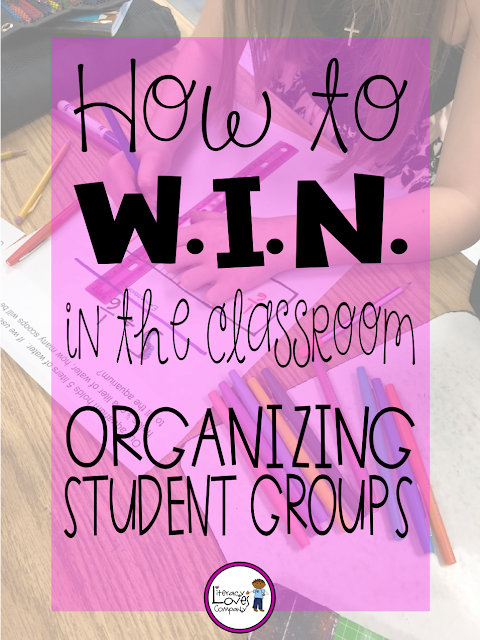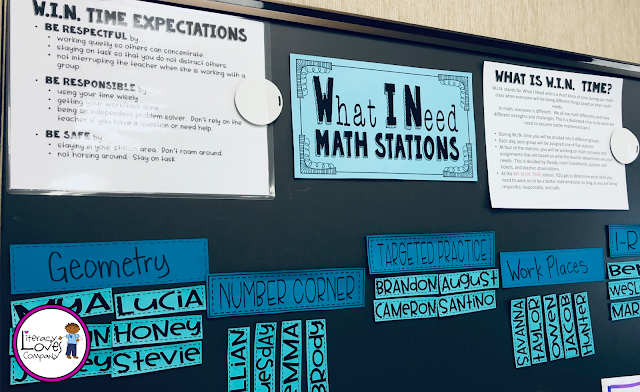My favorite part of organizing my W.I.N. rotations is figuring out what I will have students work on at each station. When planning for station activities, I am always looking at three things:
1. Does the activity meet students' needs in the area we are working on?
2. Is the activity fun yet rigorous?
3. Is the activity easy to organize, understand, and clean up so that students are able to work at it independently? This is going to look very different depending on what grade you teach.
In my class I run five to six math stations at a time, depending on how many student groups I have.
Teacher Time
As mentioned in the second post in this series, I always start my planning with the Teacher Time station. I've heard this station called many things, but it is basically the station in which you, the teacher, meet with a small group of students for direct instruction. The focus should be whatever caused you, while looking at your data, to group these students together. I am currently scoring a set of post assessments for my math students. While I am looking over their papers, I am keeping a list of students who struggled in each of the areas covered on the test. When I plan for my next round of stations, I will group my students based on the needs I noticed and focus my lesson on that skill, strategy, or concept.
Tech Time (iReady)
During Tech Time, my students work on iReady. This is software that provides students with individualized lessons and practice based on a beginning of the year diagnostic. My school is lucky to have this resource, and I know that not all schools do. There are several free online math resources that are available for students. Some examples are MobyMax and Khan Academy Two game based websites are Prodigy and Skoolbo. I have used MobyMax, Khan Academy, and Prodigy in my own classroom. My students LOVE prodigy and will even ask to stay in at recess to play it.
Number Corner
Because my school uses the Bridges curriculum, it comes with another component called Number Corner. It is probably similar to a calendar time you would see in a primary classroom. I have never taught primary, so I'm hoping this is an accurate assumption. During number corner, students are working on finding patterns on calendar markers, working with problem solving and computation, fact fluency, and measurement among other things.
Because my school uses the Bridges curriculum, it comes with another component called Number Corner. It is probably similar to a calendar time you would see in a primary classroom. I have never taught primary, so I'm hoping this is an accurate assumption. During number corner, students are working on finding patterns on calendar markers, working with problem solving and computation, fact fluency, and measurement among other things.
Game Time
Game time is a great opportunity to focus students on different skills and concepts. Games can be geared toward what you are working on in class or you can easily differentiate for each group that comes to that station. For example, my students just finished a unit on fractions. After looking through their assessments and organizing groups, I can easily have game kits ready for groups who are working on adding fractions, another for students who need review with equivalent fractions, and still another for students who are struggled with common denominators.
Targeted Skill Time
There is always a skill I would like my students to get more practice with. During this station, I focus on one skill and then differentiate within that skill. This is one of the few stations that I use worksheets in. At the beginning of the school year I invested in a subscription to Math Worksheets 4 Kids. I have found this website to be very helpful. I am able to look up worksheets my concept and then find worksheets by level. Another great website is commoncoresheets.com . Other options for this station are task cards or task mats. If you can find ones that are self-check, that is a bonus!
Geometry
Geometry seems to always be the last unit of the curriculum and the hardest to get to. Because of this, I have a geometry station. I use my math curriculum and the state standards to guide this station. My goal is to give students an opportunity to work with these concepts before state testing in May.
The above stations are the ones I currently have in my W.I.N. rotation. Some other ideas for stations are:
Fact Fluency - Practice math facts - This station would be easy to differentiate as student work on the facts they have yet to master. This station could be as easy as flash cards and timers as student work to be able to quickly recall their math facts.
Mathematical Picture Books - Sometimes reading a picture book based on a math concept can be a great way for students to connect. There are a lot of wonderful picture books available depending on what you are focusing on in class. For this station, you could have a picture book focusing on the concept you are teaching in class. Inside the book, you could ask discussion questions on sticky-notes strategically placed throughout the book. As students read, they stop to answer and discuss your question. Depending on the book, you could add an extension task.
Math Art - Integrating art into your math stations can really motivate students to participate. When working with area, symmetry, plane figures, angles, and more. The activity featured below is from a blog post I wrote a few years ago.
As you can see, there are MANY ways you can support students in stations during your W.I.N. block. The thing to keep in mind is that whatever task you are asking your students to participate in, it is one that will move them forward and help them be successful.
Once you decide on what stations would best benefit your students, try to find a space on a classroom wall, blackboard, or whiteboard to host your W.I.N. Station rotation board. This is the area you will post your station signs and student names. Click below for a free download of the station headers and sign. There are two options: Google Slideshow which is easily editable or PNGs which can be printed as is or placed in a PowerPoint slideshow and edited.
I have my W.I.N. board located on a blackboard. My signs all have magnetic tape on the back which makes it easy to move. At the end of each day, I move my station headers to the left, rather than move the student names.
As you can see, coming up with ideas for your W.I.N. stations isn't difficult! There are a plethora of options available to you. If you have a great idea for a math station that wasn't mentioned in this post, please share it in the comments below.
In my next post in this series, I will be sharing with you ideas for organizing and managing your teacher paperwork and your station materials.
• What is W.I.N.? - free download of "What is W.I.N. Time?" and "Expectations" posters.
• Organizing Student Groups - Free download of Group Organization tool
• Station Ideas - free download of editable station signs and group headers
• Managing Materials - free download of binder cover and spine
• Keeping Kids Accountable - free download of student recording sheet
• Launching a W.I.N. Block - Mystery download!
Geometry
Geometry seems to always be the last unit of the curriculum and the hardest to get to. Because of this, I have a geometry station. I use my math curriculum and the state standards to guide this station. My goal is to give students an opportunity to work with these concepts before state testing in May.
The above stations are the ones I currently have in my W.I.N. rotation. Some other ideas for stations are:
Fact Fluency - Practice math facts - This station would be easy to differentiate as student work on the facts they have yet to master. This station could be as easy as flash cards and timers as student work to be able to quickly recall their math facts.
Mathematical Picture Books - Sometimes reading a picture book based on a math concept can be a great way for students to connect. There are a lot of wonderful picture books available depending on what you are focusing on in class. For this station, you could have a picture book focusing on the concept you are teaching in class. Inside the book, you could ask discussion questions on sticky-notes strategically placed throughout the book. As students read, they stop to answer and discuss your question. Depending on the book, you could add an extension task.
Math Art - Integrating art into your math stations can really motivate students to participate. When working with area, symmetry, plane figures, angles, and more. The activity featured below is from a blog post I wrote a few years ago.
As you can see, there are MANY ways you can support students in stations during your W.I.N. block. The thing to keep in mind is that whatever task you are asking your students to participate in, it is one that will move them forward and help them be successful.
Once you decide on what stations would best benefit your students, try to find a space on a classroom wall, blackboard, or whiteboard to host your W.I.N. Station rotation board. This is the area you will post your station signs and student names. Click below for a free download of the station headers and sign. There are two options: Google Slideshow which is easily editable or PNGs which can be printed as is or placed in a PowerPoint slideshow and edited.
As you can see, coming up with ideas for your W.I.N. stations isn't difficult! There are a plethora of options available to you. If you have a great idea for a math station that wasn't mentioned in this post, please share it in the comments below.
In my next post in this series, I will be sharing with you ideas for organizing and managing your teacher paperwork and your station materials.
• What is W.I.N.? - free download of "What is W.I.N. Time?" and "Expectations" posters.
• Organizing Student Groups - Free download of Group Organization tool
• Station Ideas - free download of editable station signs and group headers
• Managing Materials - free download of binder cover and spine
• Keeping Kids Accountable - free download of student recording sheet
• Launching a W.I.N. Block - Mystery download!
FREEBIE
 |
| Domino Fractions FREEBIE. Click on image. |
I'm always adding products, free and paid, so please follow Literacy Loves Company on TpT so that you get notification. I price all of my newly added paid resources at 50% of for 48 hours, so it is a great way to save money.
Thanks for visiting Literacy Loves Company!




















